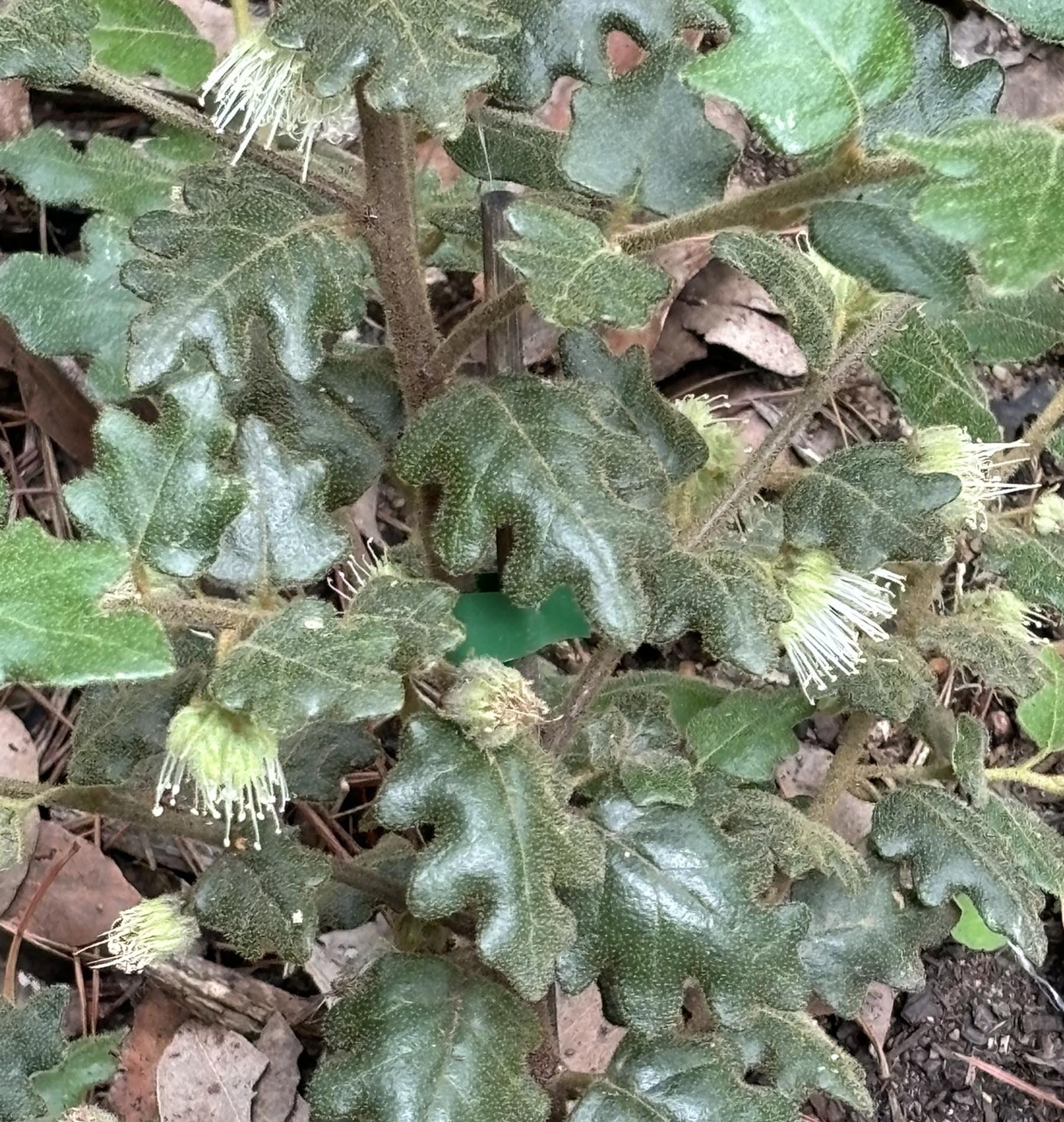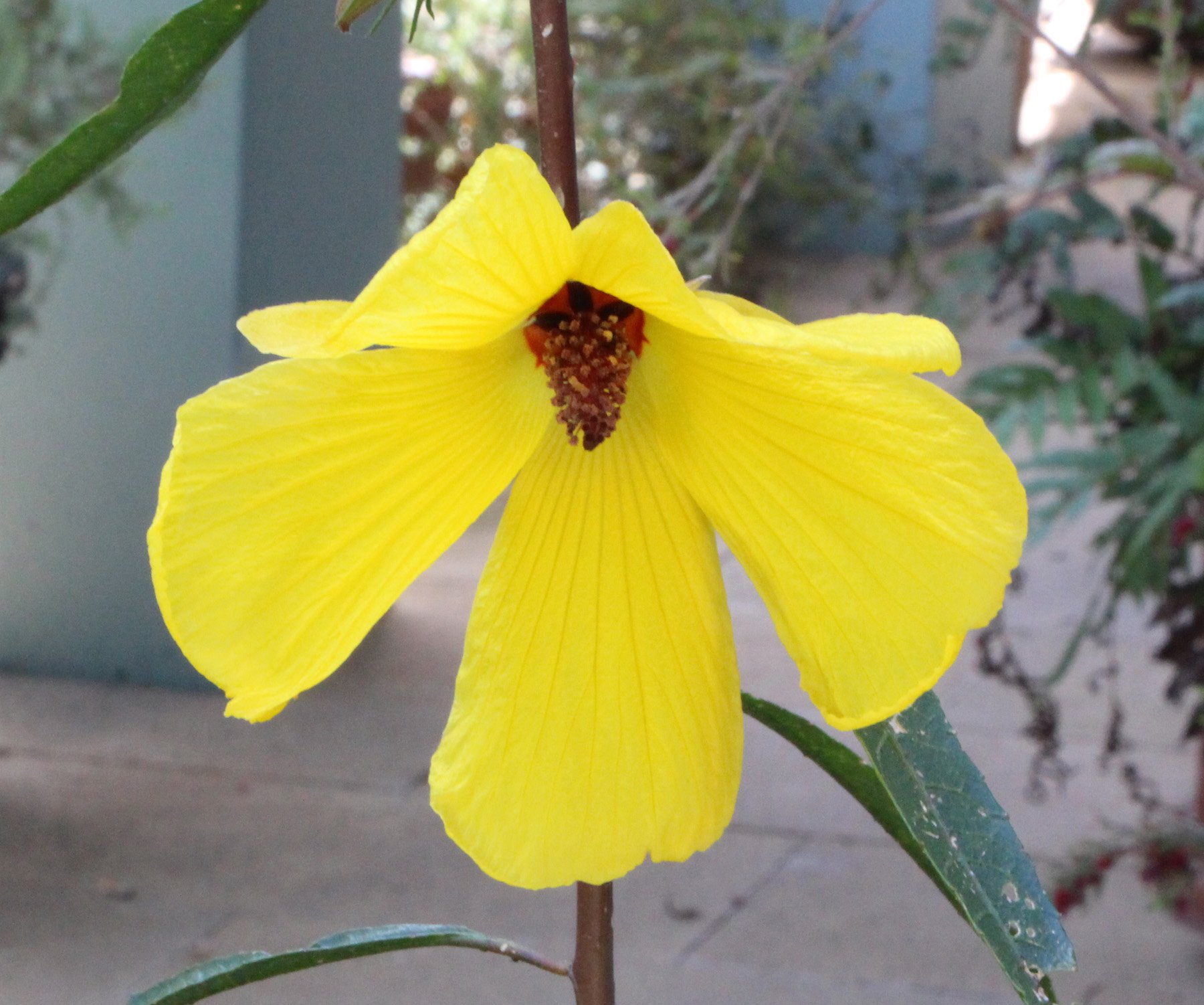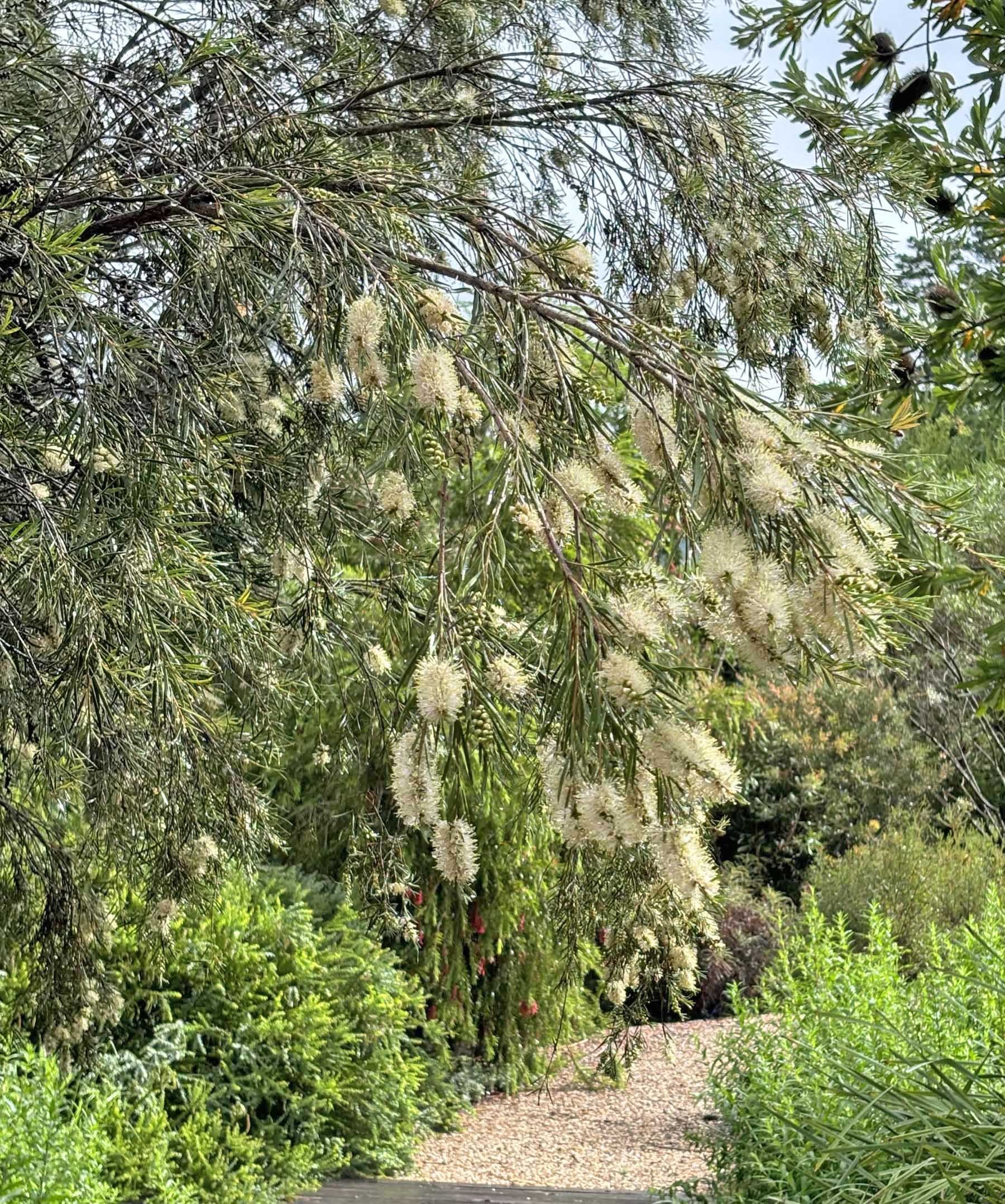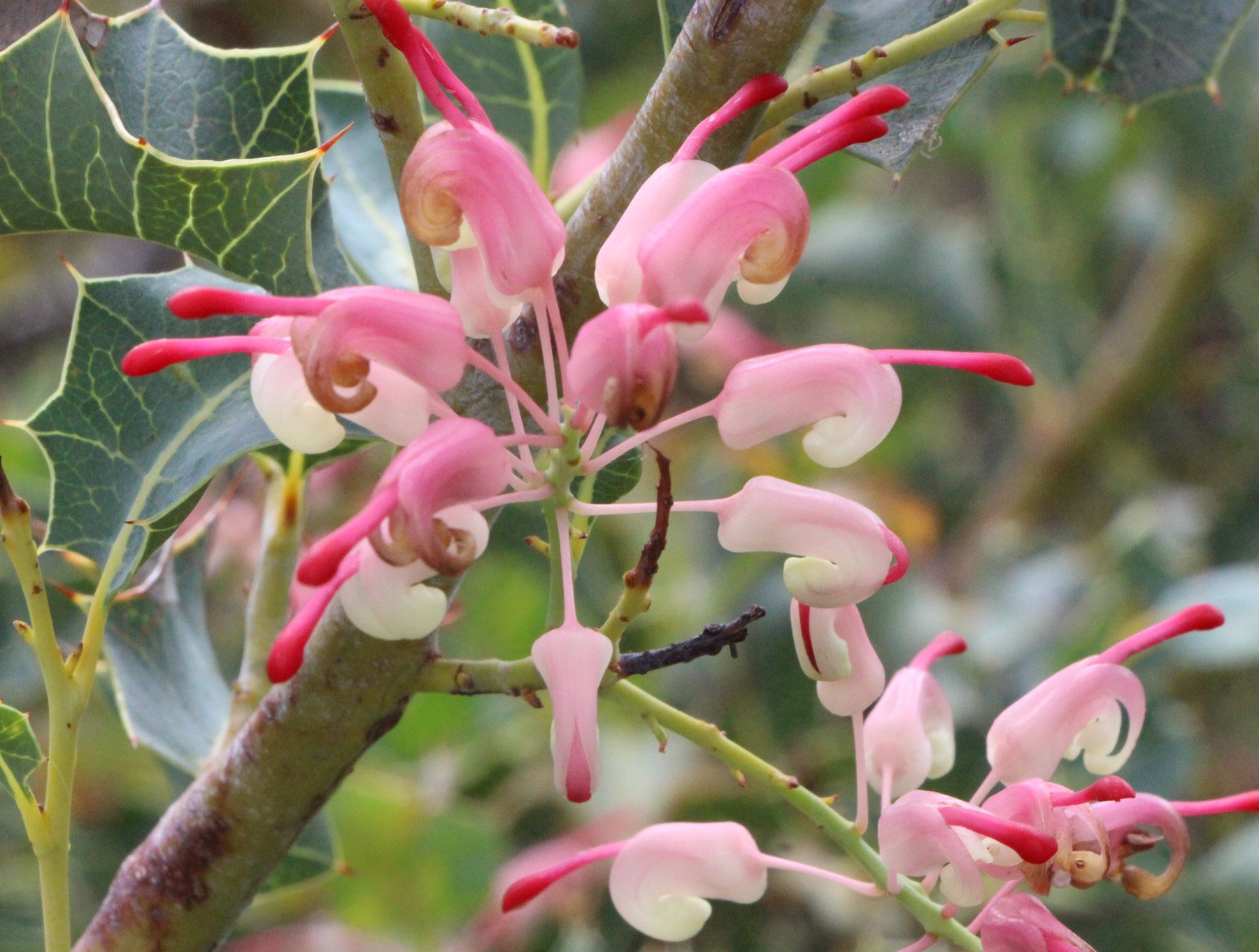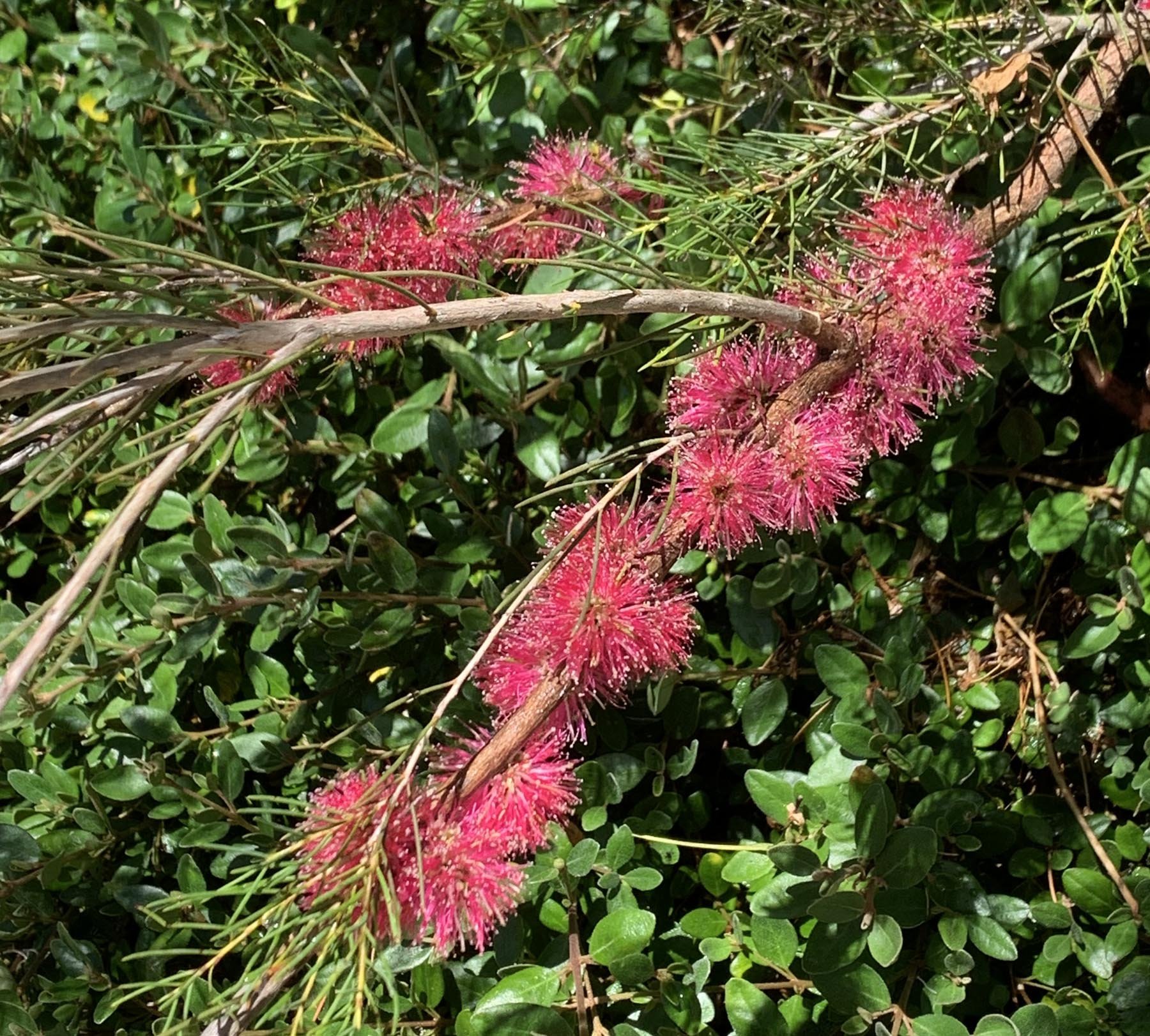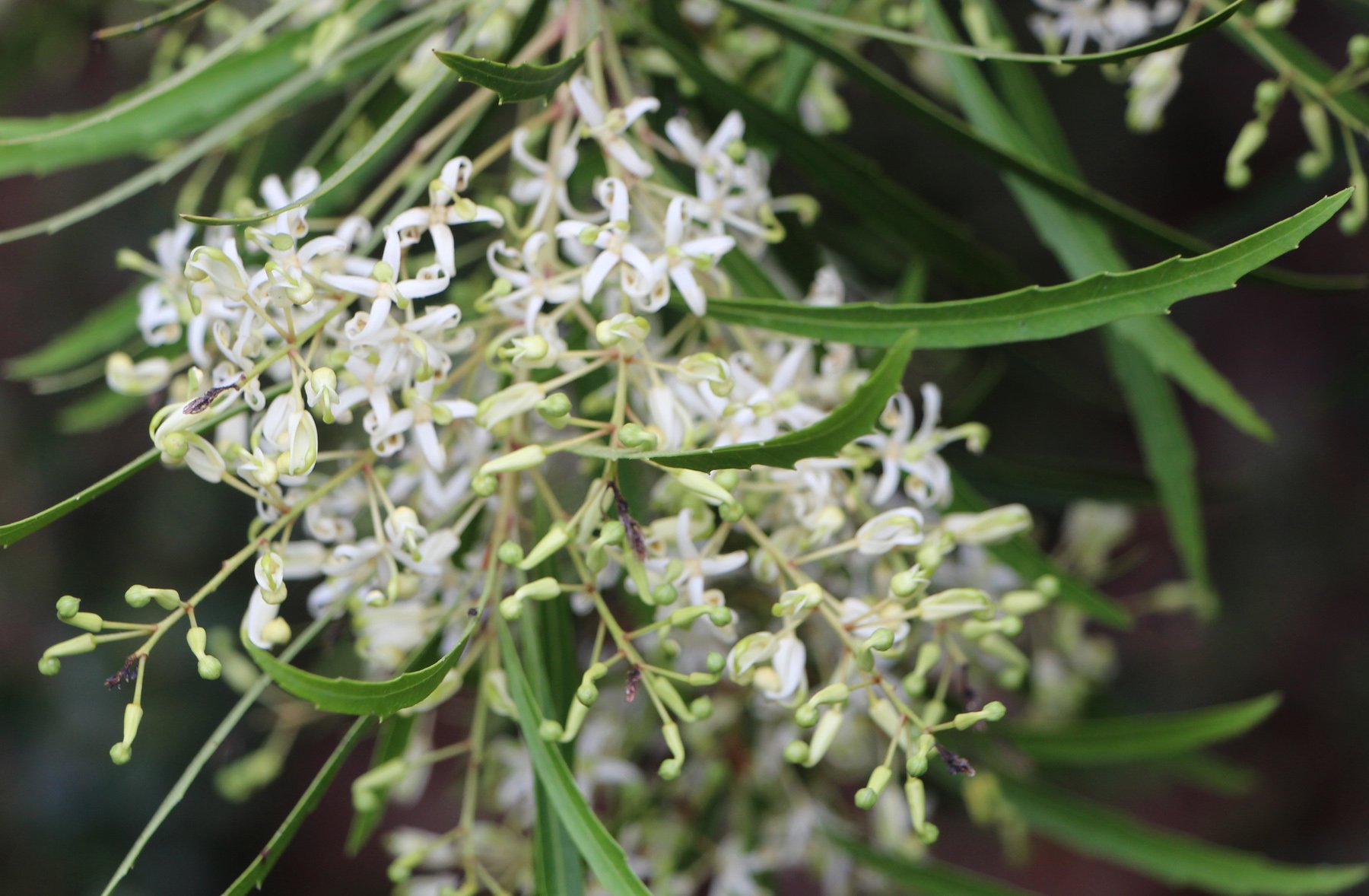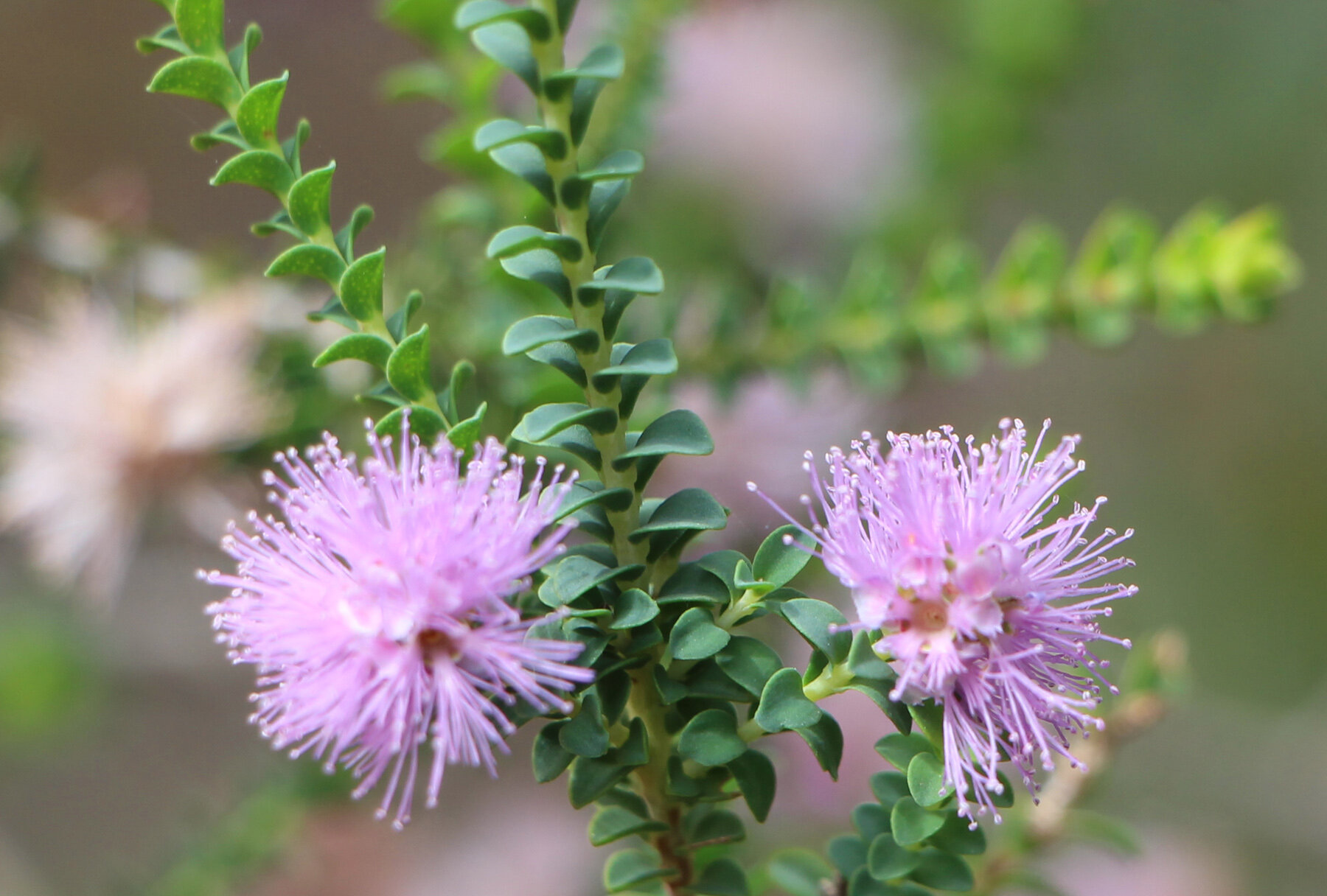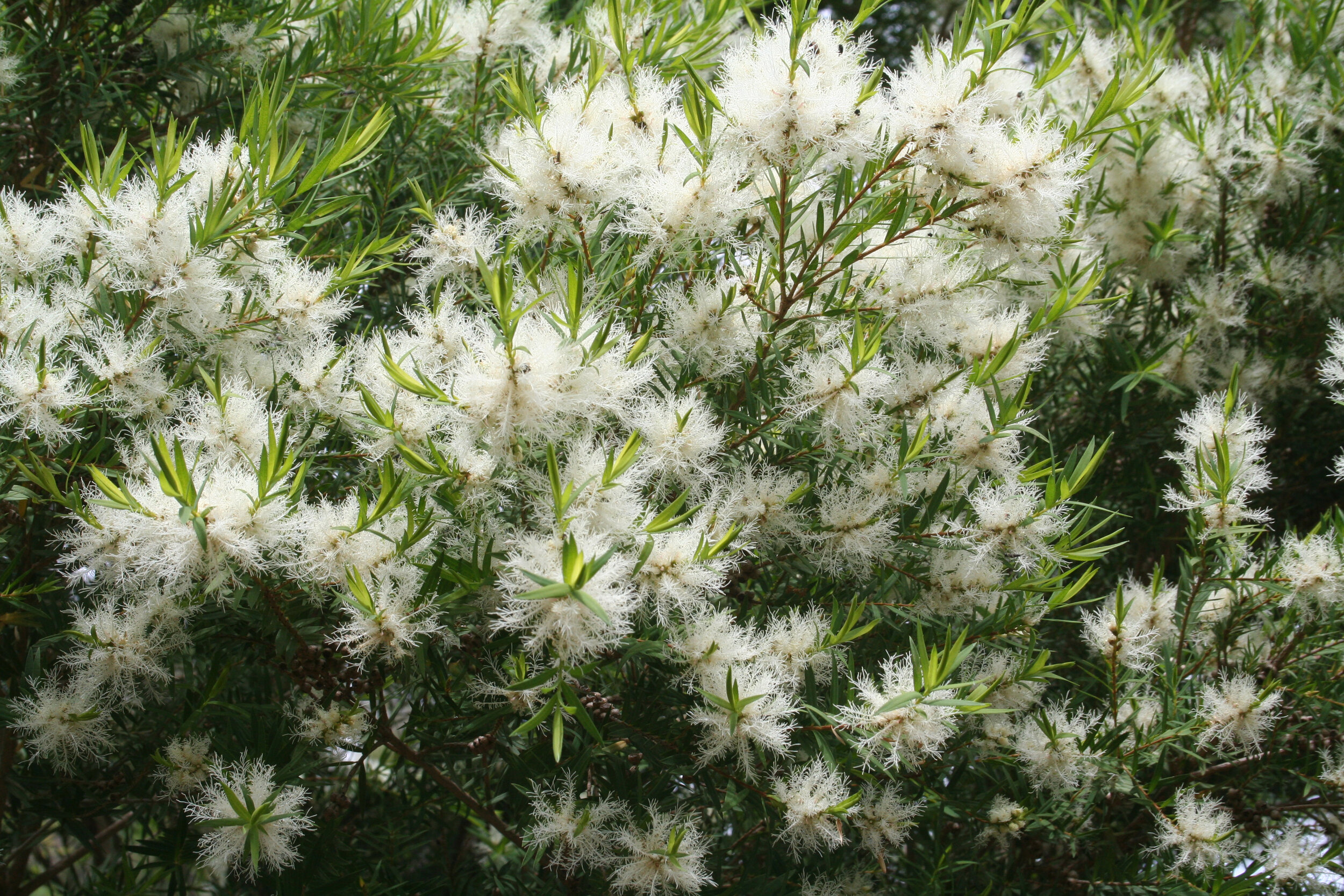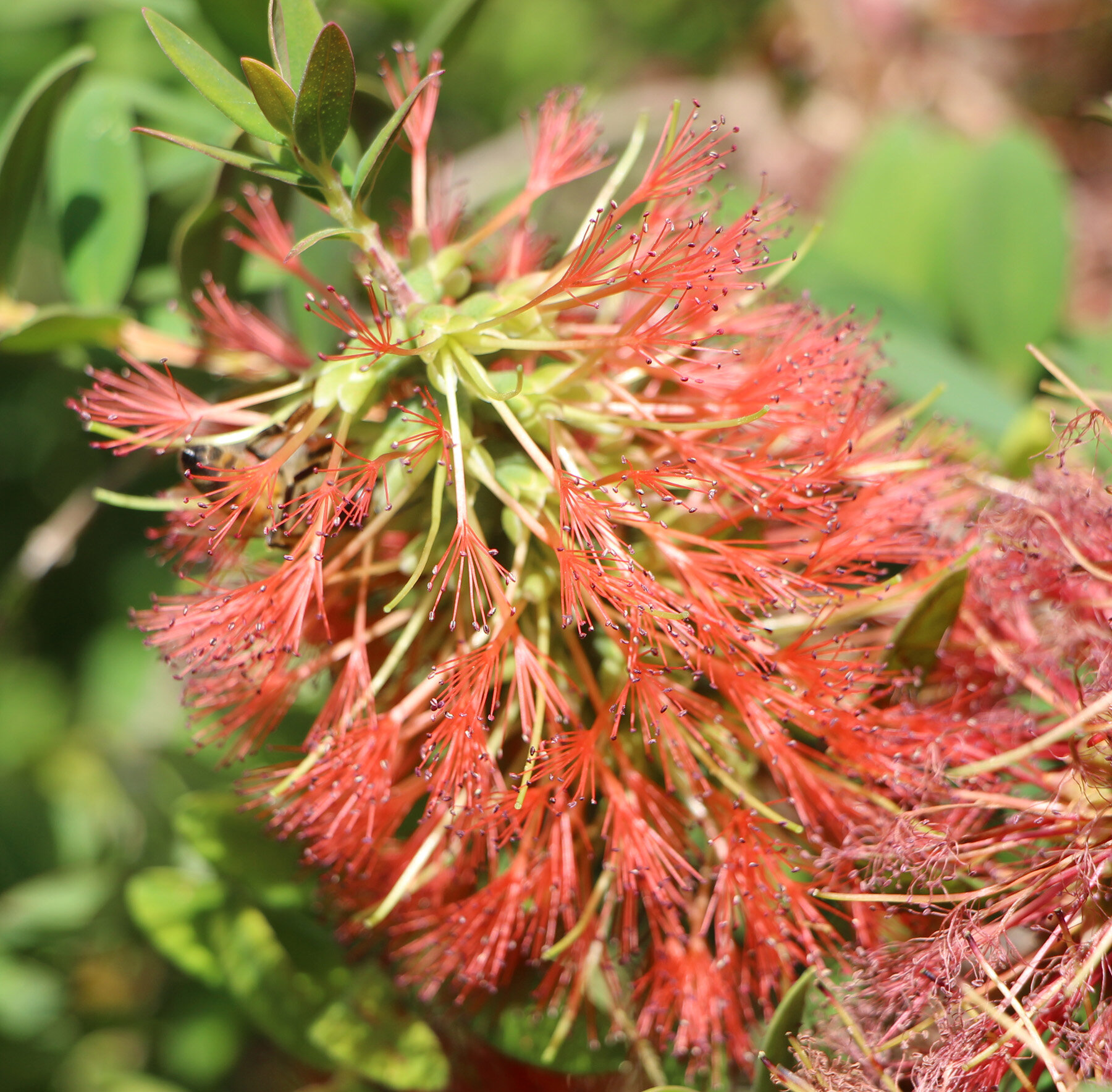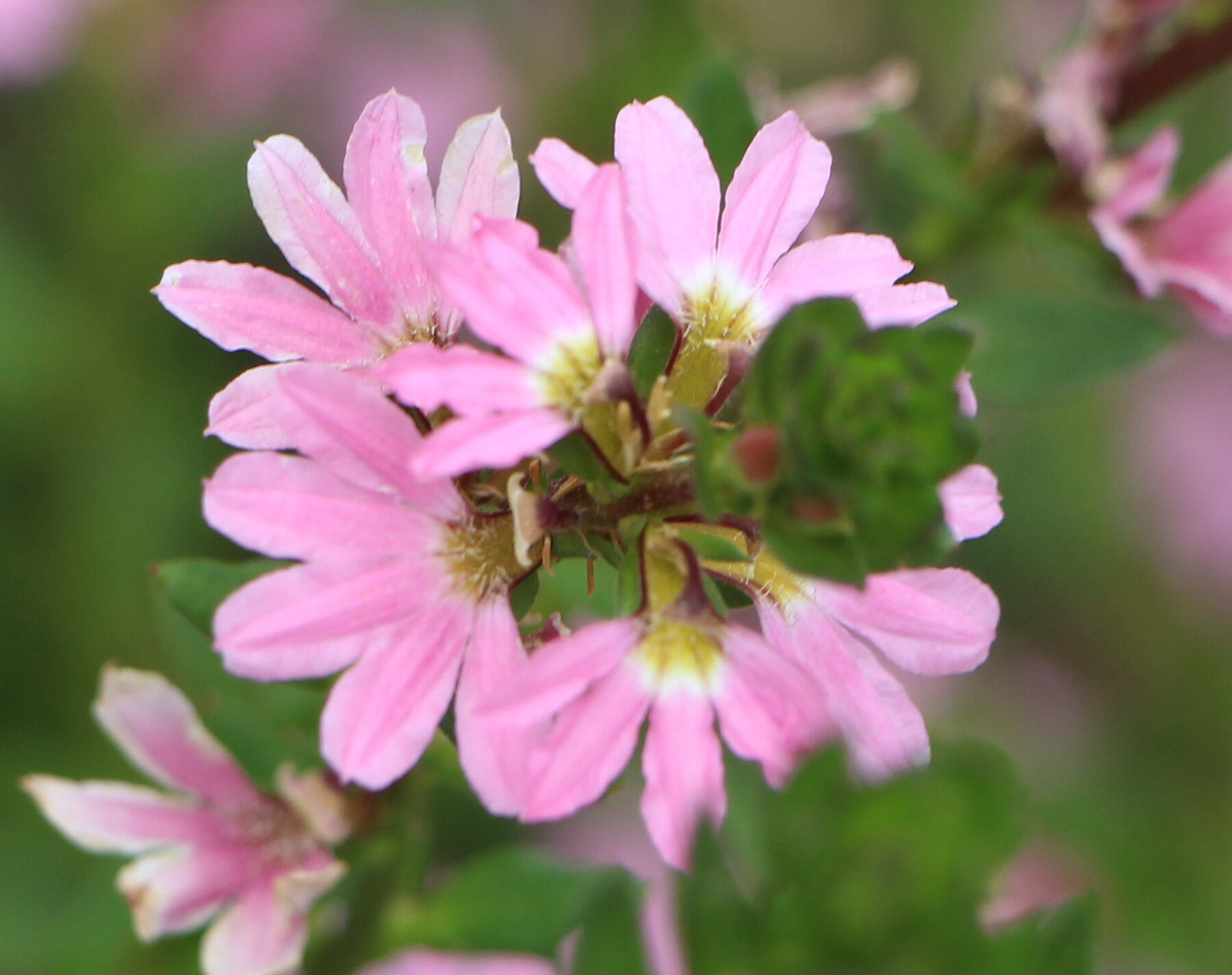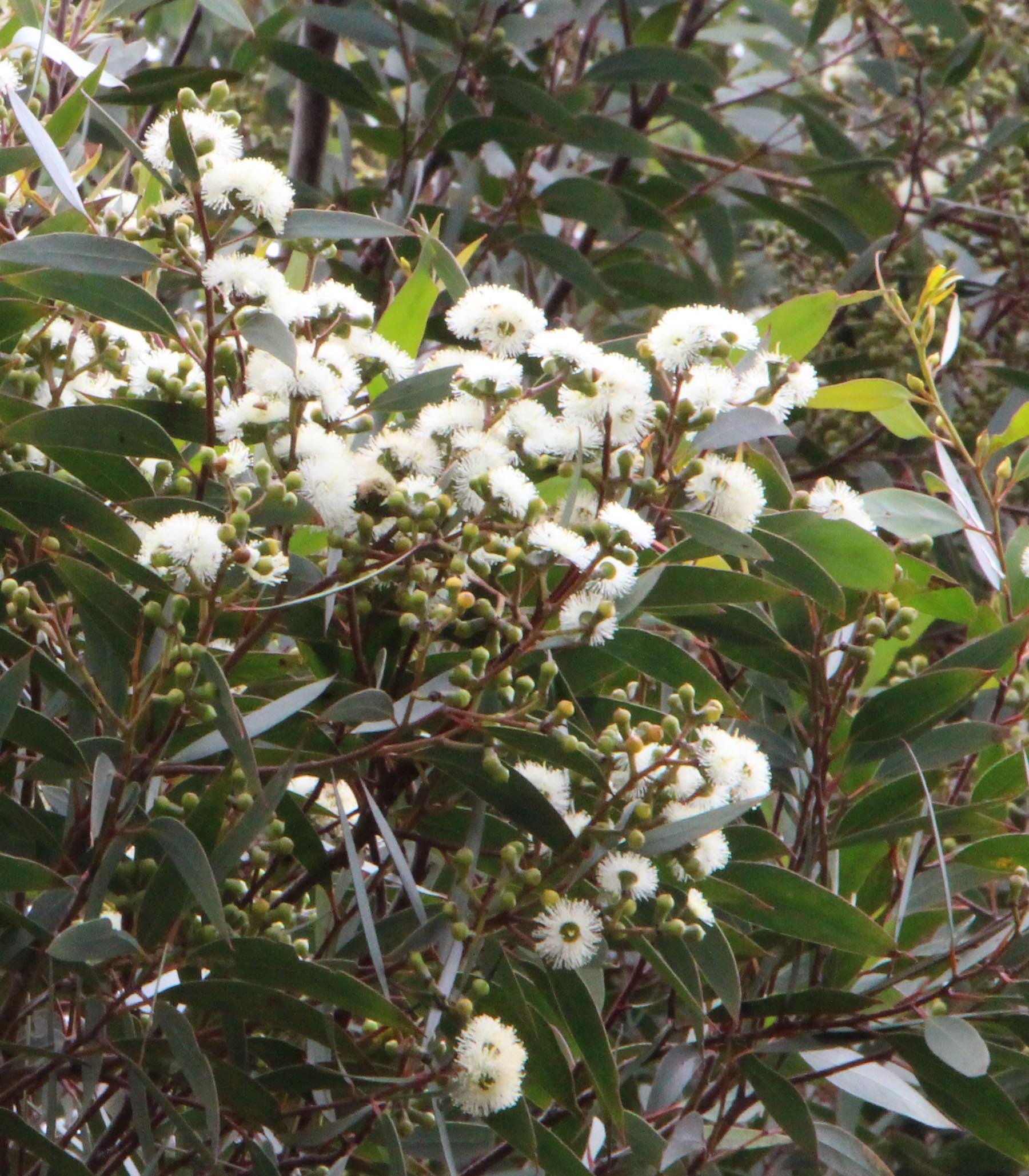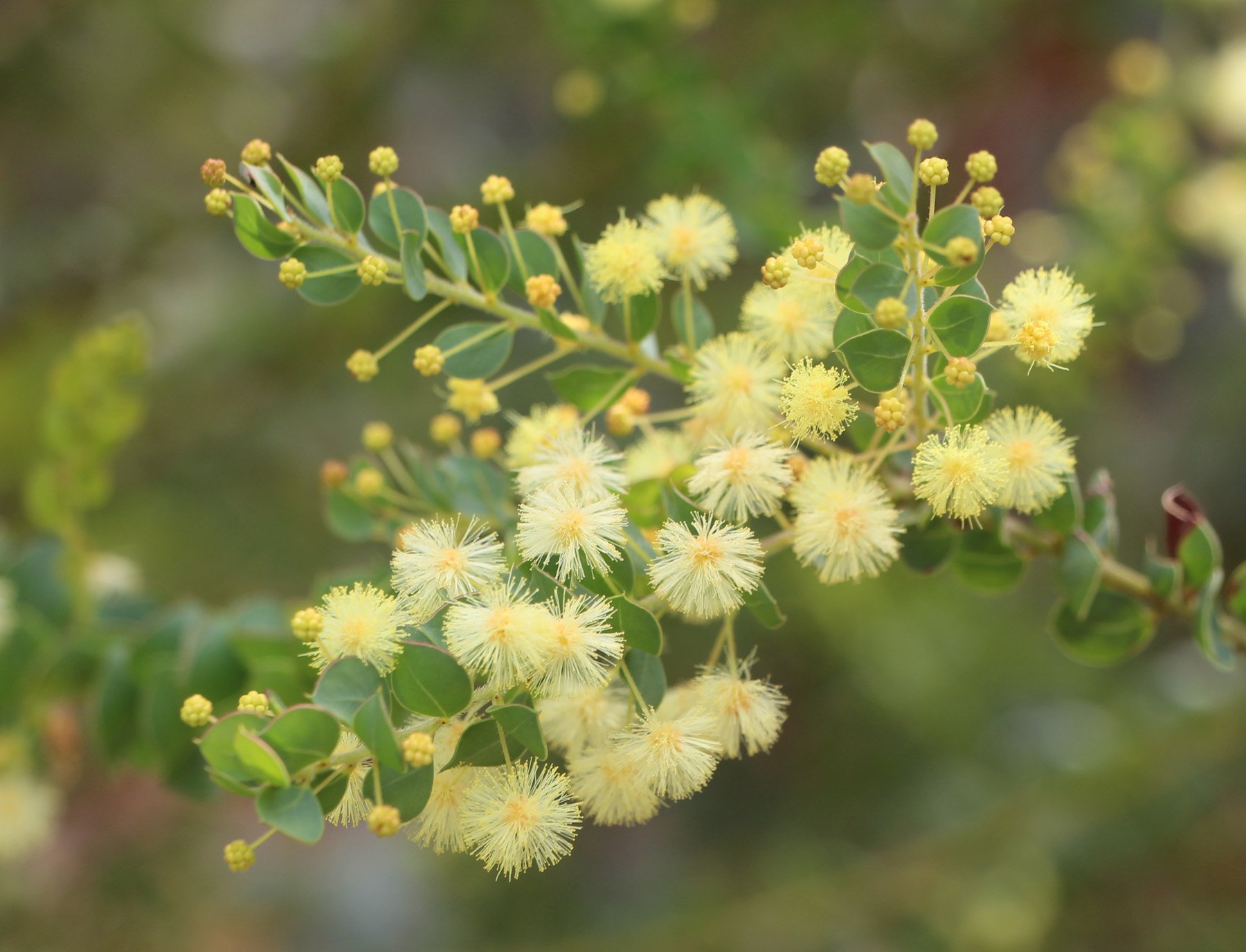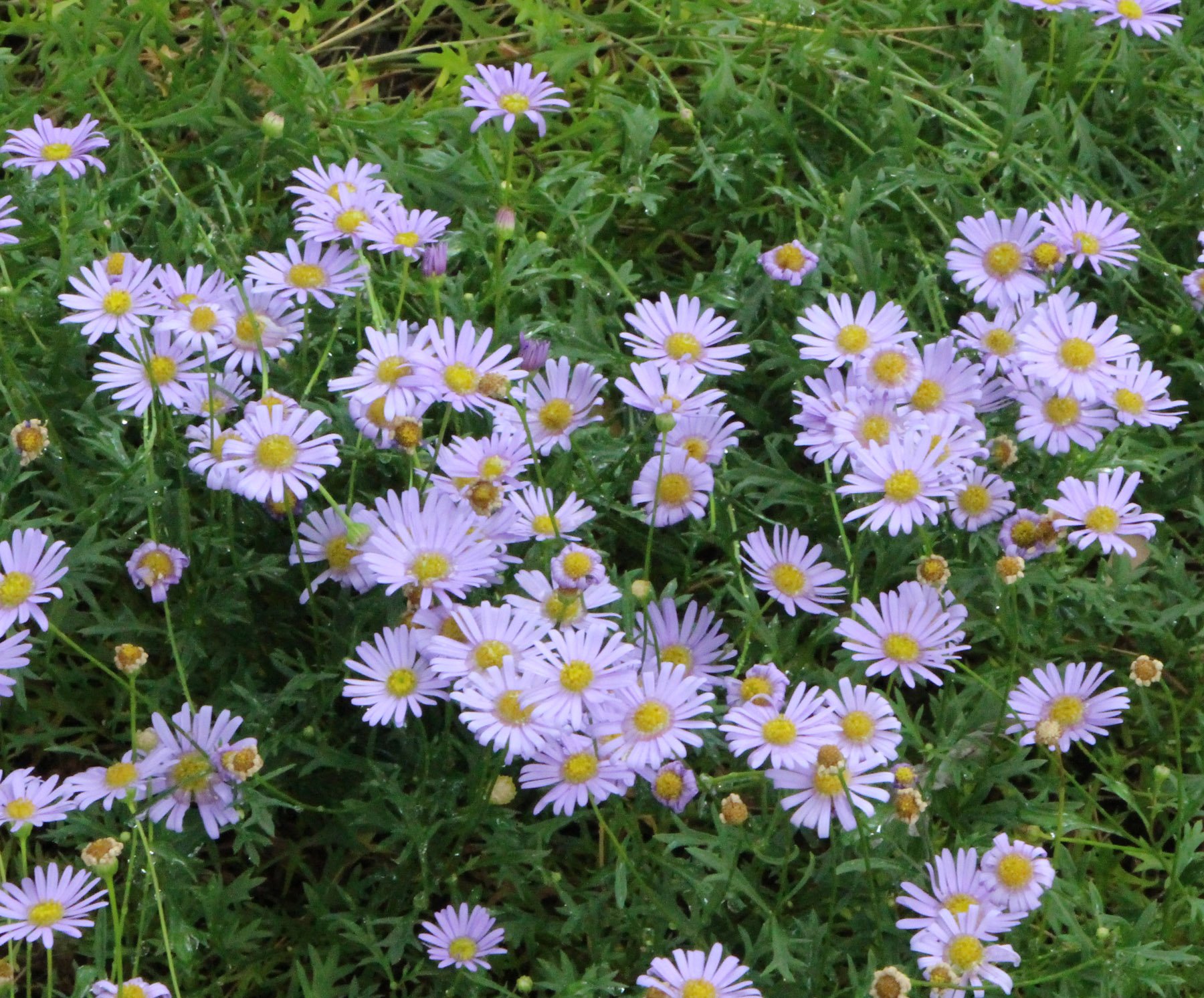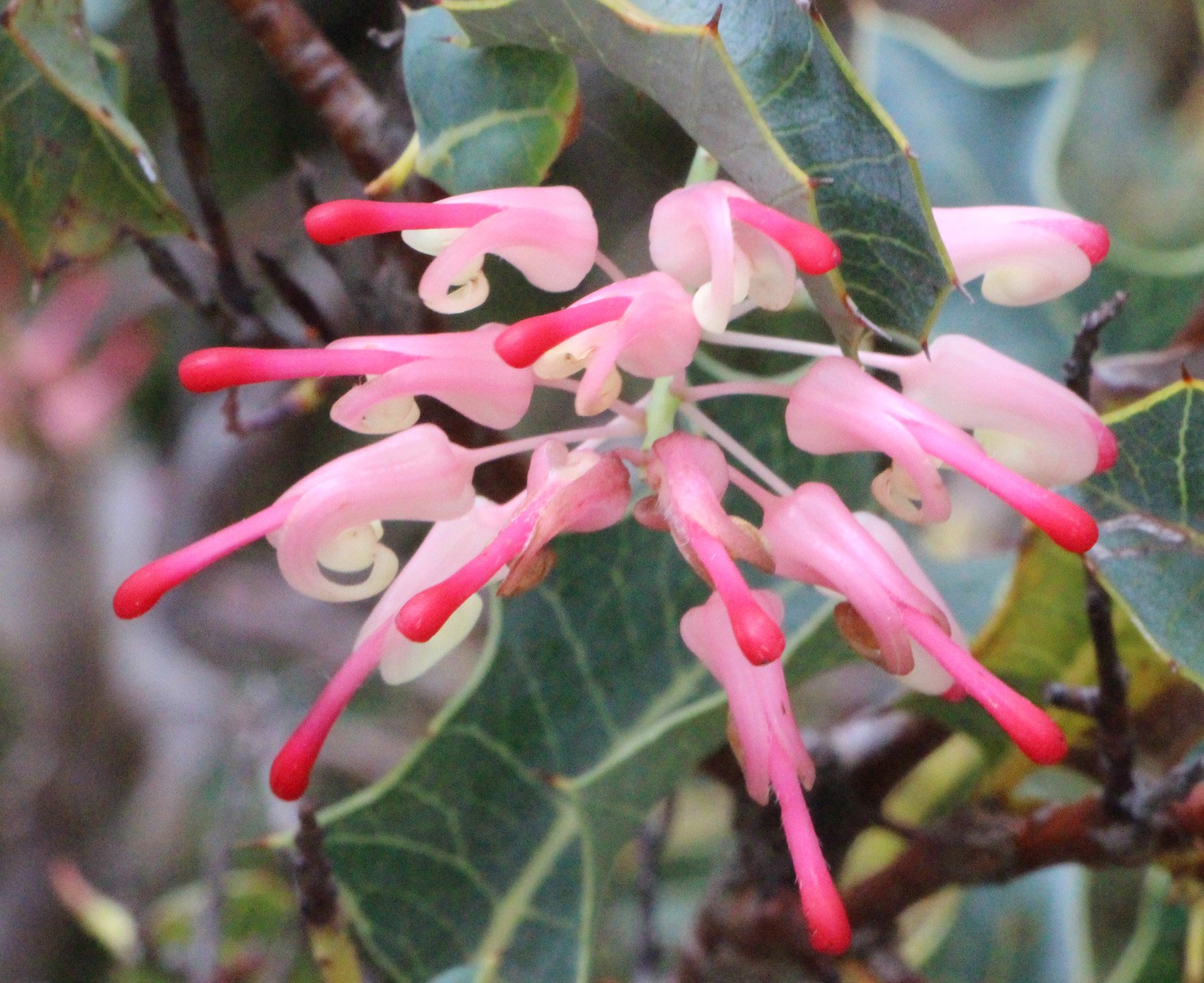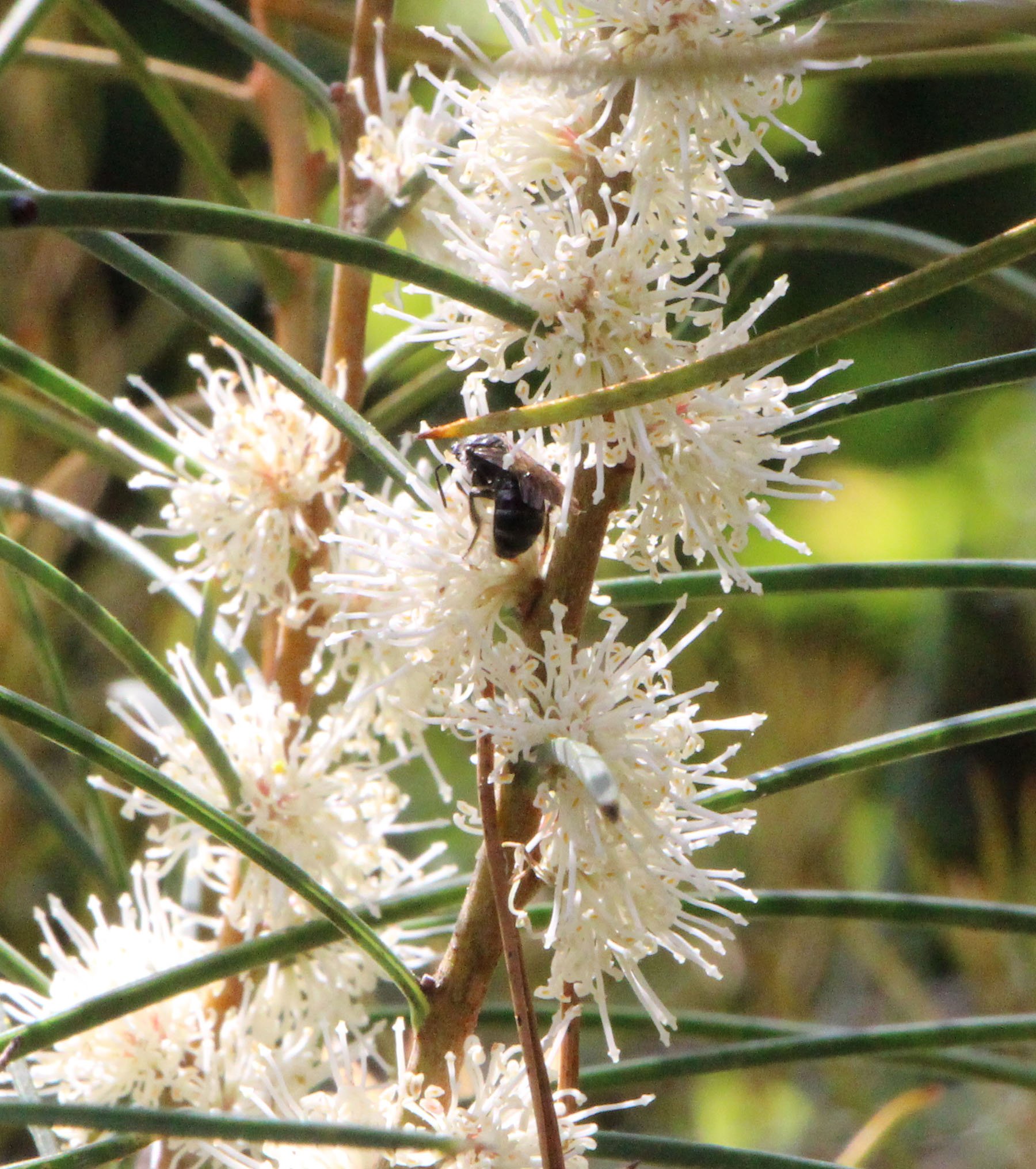December
Some plants in bloom in December
Click on any image to enlarge and scroll though all the images for each week.
Eremophila ‘Beryl’s Blue’
30 December 2024
Starting top left:
Angophora hispida
We planted three Angophora hispida, or Dwarf Apple Gum, in 2018. All three are small so far, perhaps 2m, with large drooping leaves and conspicuous white flowers in summer beloved by insects. These plants are native to the central coast of NSW.
Cassinia aureonitens – Yellow Cassinia
We planted three of these erect shrubs, 1.5-2.5m high x 1.5-2m wide, with dark green linear leaves and dense clusters of bright yellow flowers, in February 2022. These plants will thrive in full sun or shady positions in free draining soils and have moderate frost and drought tolerance. This species is native to NSW from Taree to Eden.
Grevillea x semperflorens
Grevillea x semperflorens was sold to us as ‘Mallee Dawn’ but Peter Olde quickly identified it for us as x semperflorens’, one of the earliest hybrid grevilleas ever produced. This cultivar was developed in England and was first formally described in 1937 by F.E. Briggs in The Journal of the Royal Horticultural Society of London as Grevillea semperflorens. We planted three in September 2007 and quickly realised our mistake as they grew much too large for their position and had to be removed. We planted another in February 2019 in a better spot, but this one disappeared for a few months, but has now reappeared and is flowering. The flowers are a lovely soft apricot colour. We have planted five more of these plants in October 2022.
Lagunaria patersonia – Norfolk Island (or Lord Howe Island) Hibiscus
We planted this small to medium tree, 13m high, with pink flowers in spring, in a pot in February 2024. This plant prefers a full sun to partly shady position, and must be frost protected when young. The hairs on the fruit can cause irritation.
Lomatia arborescens
We planted this tall shrub or small tree, 6m high by 3m wide, with light green oblong leaves with toothed margins and sprays of cream flowers, in April 2005. This plant has attractive glossy foliage and enjoys heavy shade and well composted soil. This plant is native to the area north from Barrington Tops, NSW to southeastern Queensland.
Lythrum salicaria – Purple Loosestrife
We planted 5 of these erect perennials in 2004-5, growing to 2m with opposite leaves and spikes of purple flowers in late spring or summer. This plant is native to southeastern Australia and also to Europe, Asia and North America. Our plants have naturalized around the pond. We cut them to the ground in early winter and they rebound with vigour.
16 December 2024
Starting from the top left:
Acacia aneura - Mulga
We have planted two of these small trees or large shrubs, 4m high x 2m wide, often multi-stemmed. These plants have narrow greyish phyllodes and yellow rod flowers mainly in spring. So far in our garden they are very slow to grow. This plant is native to arid inland areas of all mainland states.
Brachychiton bidwillii - Little Kurrajong
Brachychiton bidwillii, planted in a pot in 2013, has grown to 3 metres tall. This plant needs protection from the frost as it comes from dry rainforest from southeastern Queensland to Bowen in the north. The foliage is one of its distinctive features with five lobed felty leaves reminiscent of a human hand. The flowers are bell shaped and coral red, coming for us appropriately at Xmas. Flower production is supposed to increase with age, so we are looking forward to even more flowers in future. Moved to garden January 2024, as it became too tall for its position and has survived its first winter.
Grevillea sericea ssp. sericea pink form
We planted this evergreen shrub, 1-2m high x 2m wide, with many dainty pink flowers in February 2022. This plant prefers a partly shaded site, but will tolerate full sun and can withstand dry periods and moderate frost. Native to the area around Sydney.
Hibiscus heterophyllus ‘Lutea’
We planted this open shrub, 4m high x 3m wide, with lobed leaves and large yellow flowers with maroon centres, in a pot, in March 2022. This plant needs well drained soils, is tolerant of light shade, and must be protected from frost. Moved to garden in September 2024 and is flowering well. We will see if it can survive the winter in 2025.
Leptospermum ‘Burgundy’
We planted Leptospermum ‘Burgundy’ in March 2005 and it grew well originally showing its attractive burgundy coloured foliage until the heat and drought of 2014 caused it to fail. We planted another in August 2018 and covered this plant for its first winter. This plant has grown to 1.5m tall so far and bloomed first for us in 2020. This cultivar can grow to 3m high and 1.5m wide.
Xeronidium ‘Unity’
Hybrid strawflower, Coronidium x Xerochrysum, 50cm high x 45cm wide, with bright yellow flowers from spring until autumn. Best in a sunny position with moist soil. Deadhead. Bred by Peter Ollerenshaw, Bywong Nursery.
1 December 2024
Starting from the top left:
Acacia cremiflora
We planted three of these rounded shrubs, 1-1.5m high x 2m wide, with green circular foliage on arching branches and cream flowers in 2016-17. These plants bloom at least three times a year and their foliage, dark seed pods and umbrella shape is pleasing at all times of the year. This plant is native to central NSW, near Orange. One removed February 2024 and replaced.
Brachychiton ‘Bella Pink’
We planted this hybrid tree, B. populneus x acerifolius, height 6-8m and width 3-4m, with glossy lobed foliage and clusters of salmon pink bell flowers that appear in summer, in December 2013. The flowers are attractive to birds. Absolutely covered in flowers in December 2023.
Bursaria
We planted three different subspecies of Bursaria spinosa after asking George Adams, (author of Birdscaping Your Garden and Complete Guide to Australian Birds), which plant he felt was most beneficial to birds in the garden. He nominated Bursaria for its prickly nature and masses of white flowers that attract insects at Christmas season. We planted Bursaria spinosa ssp lasiophylla and Bursaria spinosa ssp. spinosa in the garden in 2011. We also planted Bursaria spinosa, Native Box or Blackthorn, four in 2012, and then 20 more in 2018 along one boundary of our property. These are all growing well and achieving great thorniness. We have yet to see a nest in one, but these plants are still small. These plants are native to the eastern and southern half of Australia and not in Western Australia or the Northern Territory.
Corymbia citriodora ‘Baby Citro’
We planted two Corymbia citriodora ‘Baby Citro’ in 2015 in the new sand garden. This is a grafted compact form of the larger Lemon Scented Gum. These have grown well to 3m high and had their first flowers in November 2020 – very pretty.
Hibiscus ‘Aussie Delight’
We planted this hybrid hibiscus, H. heterophyllus x H. divaricatus, 2m high x 1.5m wide, a fast growing shrub with glossy green leaves, red-brown stems and scented light pink flowers, in March 2021. The stems are covered in irritating hairs.
Melaleuca teretifolia ‘Georgiana Molloy’
We planted Melaleuca teretifolia ‘Georgiana Molloy’ in February 2019 in the upper sand garden. This plant should grow to 2.5m, high and 1m wide, with narrow dark green foliage with bronze new growth and pink-purple flowers. Our shrub has now grown to 2m high and flowers each November.
31 December 2023
Starting from the top left:
Acacia pruinosa
We planted, in November 2011, one of these small trees to 6m high with red to purplish bark and glaucous branches, ferny foliage with red new growth, attractive seed pods and sprays of golden ball flowers in January. This tree is native to Victoria, New South Wales and southeastern Queensland.
Chorilaena quercifolia
We planted this bushy shrub, 2m high x 2m wide, with oak-like foliage and pendulous clusters of green flowers, which are attractive to birds, in November 2023. This plant prefers dappled to heavy shade in moist, well-drained soil.
Hibiscus geranioides
We planted this annual or biennial species, 0.75m high x 0.75m wide, with dark green, lobed leaves and delicate pink flowers with a darker throat, in a pot in October 2015. This charming plant flowers over many months. We removed our original plant in 2021, as it had grown too large for its position and was not blooming so freely, but the cutting Ben made is growing and flowering well. This plant is widespread in tropical areas of Western Australia, Northern Territory and Queensland. In common with most Hibiscus species, the individual flowers last only 1-2 days but new flowers continue to open over a long period.
Leptospermum ‘Burgundy’
We planted Leptospermum ‘Burgundy’ in March 2005 and it grew well originally showing its attractive burgundy colour until the heat and drought of 2014 caused it to fail. We planted another in August 2018 and covered this plant for its first winter. This plant has grown to 1.5m tall so far and bloomed first for us in 2020. This cultivar can grow to 3m high and 1.5m wide.
Lythrum salicaria – Purple Loosestrife
We planted 5 of these erect perennials in 2004-5, growing to 2m with opposite leaves and spikes of purple flowers in late spring or summer. This plant is native to southeastern Australia and also to Europe, Asia and North America. Our plants have naturalized around the pond.
Sannantha angusta (Baeckea) Clarence River – Weeping Baeckea
We planted this open shrub, 2-3m high x 1-2m wide, with weeping branches of narrow dark green leaves and small white flowers, in November 2017. Our plant has grown very little, only to 0.5m high so far, but flowers every year.
18 December 2023
Starting from the top left:
Brachychiton bidwillii - Little Kurrajong
Brachychiton bidwillii, planted in a pot in 2013, has grown to 3 metres tall. This plant needs protection from the frost as it comes from dry rainforest from southeastern Queensland to Bowen in the north. The foliage is one of its distinctive features with five lobed felty leaves reminiscent of a human hand. The flowers are bell shaped and coral red, coming for us appropriately at Xmas. Flower production is supposed to increase with age, so we are looking forward to even more flowers in future.
Grevillea ‘Pink Candelabra’
We planted this cultivar, 3m high x 1m wide, a narrow, pencil-shaped shrub with pinkish red flowers, in July 2020. This plant does not tolerate frost, so must be protected in Canberra and is therefore in a pot under cover.
Hibiscus ‘Aussie Delight’
We planted this hybrid hibiscus, H. heterophyllus x H. divaricatus, 2m high x 1.5m wide, a fast growing shrub with glossy green leaves, red-brown stems and scented light pink flowers, in March 2021. The stems are covered in irritating hairs.
Hibiscus ‘Barambah Creek’
We planted this upright shrub, 2-3m high x 1.5-2m wide, with soft grey divided foliage and large mauve-pink flowers, in a pot in May 2022. This plant, native to Gayndah/Goomeri area of Queensland, needs a warm sunny position in well drained soil and is tolerant of only light frosts.
Hibiscus ‘Ian’s Gold’
We planted this hybrid hibiscus, dedicated to the memory of Ian Waldron, in a pot in October 2021. This plant forms a bushy shrub, supposedly 2m high x 1.5m wide, although ours has grown to 4m high, with large single gold flowers with a burgundy throat. The reddish stems are prickly. This plant needs a sunny well drained position and tolerates only light frosts, so must be protected in Canberra.
Melaleuca lateritia
Melaleuca lateritia, or Robin Redbreast Bush, is a medium shrub, supposedly 1.5m high and wide, although ours has grown to 2m x 2m. We planted eight of these in March 2004 on the corners of the parterres near the house. They flowered first for us in January 2005 and have continued to flower over long periods since then. The flowers are bright orange-red, almost Dayglo orange. If these shrubs start to look unsightly you can cut them back to the ground and they will reshoot and flower again in two years. Ben calls them the resurrection plant. This plant is native to southwestern coast of WA.
4 December 2023
Starting from the top left:
Acacia cremiflora
We planted three of these rounded shrubs, 1-1.5m high x 2m wide, with green circular foliage on arching branches and cream flowers in 2016-17. These plants bloom at least three times a year and their foliage, dark seed pods and umbrella shape is pleasing at all times of the year. This plant is native to central NSW, near Orange.
Billardiera cymosa ‘Purple’ – Sweet Apple Berry
We planted one of these twining climbers, to 2m high, with fine green foliage and purple flowers over a long period, in November 2019. This plant flowered for us first in October 2020 and is very popular with bees.
Brachychiton ‘Bella Pink’
We planted this hybrid tree, B. populneus x acerifolius, height 6-8m and width 3-4m, with glossy lobed foliage and clusters of salmon pink bell flowers that appear in summer, in December 2013. The flowers are attractive to birds.
Callistemon pityoides (syn. Melaleuca pityoides) - Alpine Bottlebrush
For many years confused with Callistemon sieberi. Native to areas above 2000 m down to around 900 m. Grows commonly in and around sphagnum bogs and swamps and along watercourses in Queensland, New South Wales and Victoria. In its mountain habitat Callistemon pityoides, 3m high x 2m wide, flowers late in the season, but when it does bloom masses of small, dense, cream (rarely pink) brushes are borne on the ends of the branches. We planted three in 2003 and they bloom reliably each year.
Gossypium ‘Flirtatious’
We recently planted, in a pot, this very attractive cultivar of Gossypium which flowers in the warmer months with large pink flowers.
Prostanthera gilesii
We planted three Prostanthera gilesii under some overhead protection in February 2017, but only one has thrived in our garden. This small compact plant, 1m high and wide, with dark green shiny leaves and large white to cream flowers blotched with violet in the throat, blooms over a long period. This plant is native to the area around Orange and Bathurst in NSW and is listed as critically endangered.
26 December 2022
Starting from the top left:
Eremophila alternifolia x bignoniflora ‘Meringur Crimson’
We have planted four of these shrubs, 3m x 2m, with long thin pendulous foliage and pinkish crimson flowers in 2018-19. These plants need well drained soil in full sun to part shade and are tolerant of drought and frost. The cultivar from the nursery is definitely pink and should properly be called ‘Meringur Pink’, while the one from a friend is truly vibrant crimson.
Grevillea insignis (grafted 31/10/09 on G. robusta) – Wax Grevillea
We were gifted a grafted specimen of this dense prickly shrub to 3m high and 2.5m across with rigid holly shaped blue-green leaves and pendant clusters of glowing pink waxy flowers from Phil Trickett in June 2010. This plant is native to southwestern WA. The veined leaves are extremely beautiful with the sun shining through them. Pruning of this plant in the beginning is essential to keep it compact otherwise it grows long slender branches. We now have a Red Browed Finch nesting in this prickly plant.
Grevillea tetragonoloba
We planted Grevillea tetragonoloba in March 2010 and it has taken a long time to grow and flower. Now it has formed a spreading shrub about 1m high and 2.5m wide with prickly leaves and red toothbrush flowers which last for a long time. It first bloomed in 2012 but has taken until last year to really flower well. This plant is native to an area between Albany and Esperance, WA.
Lomatia arborescens
We planted this tall shrub or small tree, 6m high by 3m wide, with light green oblong leaves with toothed margins and sprays of cream flowers, in April 2005. This plant has attractive glossy foliage and enjoys heavy shade and well composted soil. This plant is native to the area north from Barrington Tops, NSW to southeastern Queensland.
Melaleuca teretifolia ‘Georgiana Molloy’
We planted Melaleuca teretifolia ‘Georgiana Molloy’ in February 2019 in the upper sand garden. This plant should grow to 2.5m, high and 1m wide, with narrow dark green foliage with bronze new growth and pink-purple flowers. So far it has grown to 1m high but has not flowered.
Myoporum parvifolium ‘Centenary Carpet’
19 December 2022
Starting from the top left:
Calothamnus quadrifidus Pencil Form
We planted two of these vertical shrubs, growing 30-40cm wide and 2m high, with red flowers on old stems, in April 2018. This plant is ideal for a narrow spot and is suitable for shady positions in all soil types. Both plants browned off over winter 2018 but tolerated winter 2019 better. Both flowered in November 2019 and in the years after with showy red blooms along old stems..
Grevillea ‘Elegance’
Grevillea ‘Elegance’ (photos above) is an important shrub in our garden. We first planted one in August 2006 and another in May 2007 – these plants were both on their own roots. Then we visited the Grevillea Park in Bulli and purchased a grafted Grevillea ‘Elegance’. The grafted grevillea always bloomed more, had more attractive dark green divided foliage and grew taller than the grevilleas on their own roots. In January 2014 we removed the two on their own roots and kept the grafted grevillea which has grown enormous. It is now at least 4 metres high and wide and that is after much pruning. The waxy bright pink flowers last from spring to frost. This plant is a hybrid between G. longistyla x G. johnsonii and should more descriptively be called ‘Long John’ according to Peter Olde.
Lomatia myricoides
We planted eleven of these rounded open shrubs or small tree, 5m high by 3m wide, with dark green, narrow, sparsely toothed leaves and sprays of cream flowers, in December 2003, as part of our foundation planting. This plant is hardy in shade or sun and the flowers are suitable fo cutting. These plants are native to open forests of eastern NSW and Victoria, usually in moist locations. We cut all these plants back to the ground as all were browned off in the heat and dryness of January 2014 – all removed except one.
Lythrum salicaria – Purple Loosestrife
We planted 5 of these erect perennials in 2004-5, growing to 2m with opposite leaves and spikes of purple flowers in late spring or summer. This plant is native to southeastern Australia and also to Europe, Asia and North America. Our plants have naturalized around the pond.
Melia azedarach ‘Caroline’
We planted this selection of Melia which features a more controlled upright even, growth habit in November 2015. This tree has soft green pinnate foliage and lilac flowers – an excellent spreading shade tree with spring flowers and yellow autumn colour. 10m high x 6 m wide.
Prostanthera rupicola (was lasianthos ‘Donnybrook’)
We have planted three Prostanthera rupicola in April 2018. These form a shrub up to 2m high and wide with scented dark green foliage and mauve-pink flowers. These have grown well to 1m high and wide and have flowered for the first time in October 2019. This plant is native to southeastern Australia, Queensland, NSW, Victoria and Tasmania.
5 December 2022
Starting from the top left:
Alyogyne ‘Karana’
We planted this shrub, height 1.5m x width 1.5m, with attractive bluish foliage and masses of mauve trumpets clustered along stems, in October 2012. This plant is only moderately frost tolerant, and ours was frosted off several times, however it does bounce back with abundant flowers.
Billardiera cymosa ‘Purple’ – Sweet Apple Berry
We planted one of these twining climbers, to 2m high, with fine green foliage and purple flowers over a long period, in November 2019. This plant flowered for us first in October 2020 and is very popular with bees.
Callistemon ‘Pink Champagne’
The standout Callistemon in our garden is C. ‘Pink Champagne’, an upright tall shrub to 3m, width 2m. We first planted one in February 2004, then another in November 2005. We then planted a number of seedlings and now have at least 15 growing even after losing several when the pine fell. This plant always looks healthy, blooms at least twice a year and has the most lovely dusty pink blooms. It is also a favourite of the bowerbirds, which always have a bower under one group of these plants.
Cordyline australis ‘Sundance’
We planted Cordyline 'Sundance', 2m high, with dark green sword like leaves, shaded through the middle with a pink red colour, and creamy white flowers that appear high above the foliage in long drooping panicles, in 2003. This plant prefers a sunny or partly shaded position in well drained soil and is frost hardy
Jacksonia scoparia
We planted seven of these handsome foliage plants, attractive in flower, to 4m high by 2m across, in 2007-8. These plants feature leafless grey-green branches, often pendulous, and profuse yellow and red pea flowers which occur in spring for an all too short period. This plant is native to coastal NSW and Queensland. We have planted another two of these in 2021 in a pot and will place them in the garden when they have grown larger.
Leptospermum spectabile ‘Colo River Tea Tree’
We planted this bushy evergreen, dense shrub, 1.5m high, with glossy dark green leaves, new growth tinted red and many dark red flowers with green centres, in November 2019. This plant prefers moist well drained soil in a sunny to partly shaded position. First flowers for us in November 2022. This plant is native to the colo River in central coastal NSW.
7 December 2020
Starting from the left above:
Eucalyptus ‘Nullarbor Lime
We planted ‘Nullarbor Lime’, E. pyriformis x macrocarpa , in November 2014. This small tree is a hybrid of two iconic WA eucalypts combining large lime green flowers, grey foliage and upright habit. Height 3-4m x width 3m. This tree has large flowers followed by beautiful nuts, but was stripped of most of its flowers by the fall of a large branch of E. sideroxylon in November 2020..
Graptophyllum ilicifolium x G. excelsum ‘Holly Hedge’
We planted ‘Holly Hedge’ in a pot in November 2019. This plant forms a low bushy shrub to 1.5m with a spread of 1m. The prickly green foliage is holly-like and the brilliant red flowers appear at the end of the year.
Melaleuca diosmatifolia
We planted this melaleuca in September 2012 and it has grown much taller than the suggested 2m, more like 4m high. Syn M. erubescens. This plant has dark green leaves and is covered in small mauve flower spikes in summer.
Melaleuca gibbosa – Slender Honey Myrtle
We planted this rounded shrub to 2.5m tall and 2m wide in December 2008 with small grey-green leaves and many mauve flower spikes in summer.
Melaleuca linariifolia ‘Snow in Summer’
We planted two of these trees with attractive foliage, white paperbark trunks and copious white fluffy flowers in early summer in 2003-4. They perform best in part shade, 6-8m high. The one in more shade with less air circulation was covered in black mould and we opened it up to sun and air and removed the acacia in front of it in October 2010. The tree did not recover so we cut it to the ground. In December 2012 it began to grow again and now is as high, and blooms as well, as the original tree.
14 December 2020
Starting from the top left:
Alyogyne huegelii ‘Misty’
We planted three of these shrubs with attractive bluish foliage and many lilac flowers with a burgundy centres in December 2018. These plants bloom very generously over several months.
Banksia ‘Yellow Wing’
We planted nine of these banksia hybrids in 2006, Banksia ‘Giant Candles’ x B. spinulosa (Carnarvon Gold) ‘Birdwire’. They form a rounded shrub (1.5-1.8m x 1.5x1.8m) with fine dense foliage and many orange nectar rich flowers. This plant normally flowers in winter for us, but this year did not and is flowering now.
Billardiera cymosa ‘Purple’ – Sweet Apple Berry
We planted one of these twining climbers to 2m a year ago with fine green foliage and purple flowers over a long period. This plant is very popular with bees.
Boronia molloyae
This slender shrub with purplish pink bell flowers grows in sandy soils in southwestern coastal regions of Western Australia. Our original plant died in the heat but the three cuttings that Ben made, planted in February 2019, have flowered exceptionally well this year.
Chrysocephalum ramosissimum
We planted three of these low growing groundcovers in September 2016 which form a dense mat of orange button flowers, height 0.3m x width 1.5m. These original plants have spread widely and provided plenty of seedlings for other gardens. This plant is native to all states of Australia and is presently included as a variant of Chrysocephalum apiculatum.
21 December 2020
Starting from the top left:
Grevillea ‘Waverley Ghost’
We planted Grevillea 'Waverley Ghost', a variegated sport from a potted specimen of Grevillea 'Poorinda Constance' in the nursery of the Victorian State Schools Horticultural Society in Glen Waverley, Victoria, in September 2014. This cultivar forms a dense, bushy shrub to 1.5m high and from 1.5 to 2m wide with variegated cream and light green foliage and red flowers.
Hibbertia pedunculata ‘Boomers’
We planted three of these prostrate groundcovers to 1m wide in three pots in August 2019. They provide a brilliant display of bright yellow flowers with dense green foliage and are loved by bees and butterflies.
Hibiscus geranioides
We planted our original plant, 0.3-0.6mH x 0.3-0.5mW, with dark green, lobed leaves and delicate pink flowers in October 2015, then made several cuttings to give away. We kept one as we enjoyed the flowers over a long period.
Melaleuca hypericifolia – Hillock Bush
We planted five of these dense shrubs from the southeastern coast of NSW, to 3m high and 2.5 m across, with attractive oval foliage on slightly weeping branches and orange red brushes
Melaleuca stypheloides - Prickly Paper Bark
Paperbark tree to 10 m with prickly leaves and showy white to cream bottlebrush flowers planted in September 2007. We saw an enormous one of these in the Tasmanian Botanic Gardens, but it was considerably older than ours.
28 December 2020
Starting from the top left:
Brachychiton bidwillii – Little Kurrajong
We planted a gift Little Kurrajong in a pot in February 2013. This small tree to 4m high is found growing naturally from southeastern Queensland to Bowen in the north, and has spectacular salmon bell shaped flowers in clusters on the stem at Xmas.
Lythrum salicaria – Purple Loosestrife
We planted 5 of these erect perennials in 2004-5, growing to 2m with opposite leaves and spikes of purple flowers in late spring or summer. This plant is native to southeastern Australia and also to Europe, Asia and North America. Our plants have naturalized around the pond.
Pandorea jasminoides ‘Pink Magic’
We planted this evergreen climber with a neat habit and profuse flowering from spring until autumn with sprays of large pink blooms with darker pink throats in April 2008 and it has climbed through a Callistemon ‘Kings Park Special’ with some vigor.
Scaevola ‘Sitting Pretty’
We planted three of this Scaevola humilis selection in February 2015. The pink flowers are attractive over a long period, but our three plants are not very vigorous.
Swainsona galegifolia burgundy
We have planted many of this long-lived upright plant to 1.5m high with many stems of pinnate leaves and sprays of burgundy pea flowers spring summer and autumn. This plant is native to NSW and southeastern Queensland.
6 December 2021
Banksia plagiocarpa ‘Hinchinbrook’ – Blue Banksia
We planted this shrub to 5m high with a short trunk and spreading crown in a pot in August 2019. The flowers pale blue grey to mauve in bud, then dull yellow when open. This banksia is native to Hinchinbrook Island, Queensland where it grows in sandy loam on rocky slopes. The red, velvety new foliage changes to rusty fawn, then green.
Boronia heterophylla x B. molloyae ‘Carousel’
We have planted two of these shrubs in pots, 2m high x 1.5m wide, with fine needle-like aromatic foliage and many fragrant pink bell flowers which deepen to red, in 2019 and 2021. These plants prefer a cool, partly shaded position in moist, well-drained soil. The first one died in heat os January 2020, but the second persists.
Eremophila mackinlayii subsp. spathulata
This shrub, 1.5m x 1.5m, with grey green leaves and large blue-purple flowers is one of our most reliable bloomers in the garden. We planted one in October 2017 and another in May 2019. The first planted has grown to its full size, is dense and well shaped and very rarely out of flower.
Eremophila racemosa ‘Peaches and Cream’
We planted this quick growing attractive upright shrub, 0.3-1m high by 0.3-1m wide, with many lemon-gold flowers which open to cream coloured, contrasting nicely with the mid green foliage, in April 2020. This plant blooms in spring and again in autumn, and will attract nectar loving birds. First flowers 10/20.
Pimelia ferruginea ‘Magenta Mist’
Green dense shrub rounded to 1m high with many magenta to pink terminal flower heads from spring to autumn. Small oval opposite leaves are packed in four ranks around the stem. Lightly shaded position and well drained soils.
Scaevola ‘Bright Eyes’
We planted two of these groundcovers, prostrate x 1m wide, with white eyed purple flowers on dense green foliage, in April 2021. This plant needs well drained soil in full sun or part shade, and is frost hardy and drought resistant.
15 December 2021
Eremophila bignoniifolia x polyclada ‘Big Poly’
We planted Eremophila bignoniifolia x polyclada, or ‘Big Poly’, in April 2008 and after a rocky start this plant has grown to 3m high and wide in our garden. This plant has dark green strappy leaves with white flowers with lilac spotted throats in profusion. This plant responds well to pruning.
Eucalyptus stricta - Broad-leaved Sally
We planted one Eucalyptus stricta, or Broad-leaved Sally, or Blue Mountains Mallee Ash, in October 2006. This mallee has a spreading crown and long lasting white flowers in summer and first bloomed for us in December 2008. Our tree has grown to 5m high. This species occurs naturally on the Newnes Plateau to Budawang Ranges in central NSW.
Melaleuca decussata dwarf
We planted ten of these evergreen small shrubs with fine blue-green foliage and mauve bottle brush type flowers half in 2004-6 and half in 2017-8. Height to 1m. Many of the early plants succumbed to webbing caterpillar.
Melaleuca diosmatifolia
We planted Melaleuca diosmatifolia in September 2012, a shrub suggested to be 2m high and wide, but our plant has grown much taller, perhaps 3.5m high with linear dark green leaves and small mauve flower spikes. This plant is native from the Sydney area north to southeastern Queensland.
Melia azedarach ‘Caroline’
We planted this selection of Melia which features a more controlled upright even, growth habit in November 2015. This tree has soft green pinnate foliage and lilac flowers – an excellent spreading shade tree with spring flowers and yellow autumn colour. 10m high x 6 m wide.
Scaevola ‘Purple Fanfare’
We have planted 20 of this free flowering form of Scaevola aemula from Diamond Head, NSW. Slugs love them – put down slug bait. The flowers are purple and last for many months.
20 December 2021
Starting from the top left:
Acacia cremiflora
We planted three of these rounded shrubs, 1-1.5m high x 2m wide, with green circular foliage on arching branches and cream flowers in 2016-17. These plants bloom at least three times a year and their foliage, dark seed pods and umbrella shape is pleasing at all times of the year.
Brachyscome formosa ‘Bonstar Mauve’
We planted three of these compact groundcovers, with mauve flowers in February 2015. These plants will tolerate only light frosts so we have planted them under a cypress where they have spread and flowered well each year.
Graptophyllum ilicifolium x G. excelsum ‘Holly Hedge’
We planted this low bushy shrub, 1.5m high x 1m wide, with prickly foliage and brilliant red glossy ‘fuchsia’ flowers in a pot in November 2019. This plant had its first flowers in November 2020 and bloomed for two months.
Grevillea insignis (grafted 31/10/09 on G. robusta) – Wax Grevillea
We were gifted a grafted specimen of this dense prickly shrub to 3m high and 2.5m across with rigid holly shaped blue-green leaves and pendant clusters of glowing pink waxy flowers from Phil Trickett in June 2010. This plant is native to southwestern WA. The veined leaves are extremely beautiful with the sun shining through them. Pruning of this plant in the beginning is essential to keep it compact otherwise it grows long slender branches. We now have a Red Browed Finch nesting in this prickly plant.
Leptospermum ‘Burgundy’
We planted Leptospermum ‘Burgundy’ in March 2005 and it grew well originally showing its attractive burgundy colour until the heat and drought of 2014 caused it to fail. We planted another in August 2018 and covered this plant for its first winter. This plant has grown to 1m tall so far and has bloomed for us in 2020. This cultivar can grow to 3m high and 1.5m wide.
Melaleuca linariifolia ‘Snow in Summer’
We planted one Melaleuca linariifolia ‘Snow in Summer’ in December 2003 and another in March 2004. These form a shapely, bushy tree , 6-8m high, have attractive light green foliage, white paperbark trunk and many white fluffy flowers. One of our trees grew very well but the other was not in enough sun and air and was covered in sooty mould. We opened up around this tree in October 2010, but cut it down in December 2010. Since then it has grown again and is almost as tall as the original plant.
27 December 2021
Starting from the top left:
Alyogyne ‘Karana’
We planted this shrub with attractive bluish foliage and masses of mauve trumpets clustered along stems in October 2012. This plant is only moderately frost tolerant, and ours was frosted off several times, however it does bounce back with abundant flowers. Height 1.5m x width 1.5m.
Eleaocarpus reticulatis - Blueberry Ash
We planted 22 Eleaocarpus reticulatus ‘Prima Donna’, or Blueberry Ash, and have retained about 15 of these despite the damage caused by severe frost two years ago, 2018. These trees have flowered only a few times, after rain, but when they do, are very beautiful. When not flowering they provide glossy green foliage for a ‘rainforest’ look, rare in Canberra.
Hakea rostrata - Turkey Gobblers
We were given 5 Hakea rostrata collected from Kangaroo Island, (wider distribution southern SA), in February 2010. They have grown slowly to 2m high and 1.5m wide with greyish linear leaves and white axillary flowers. Since the removal of some other trees blocking their sun they have become more vigorous and now show the unusual large fruits that gives them the common name of Beaked Hakea or Turkey Gobblers.
Hymenosporum flavum – Australian Frangipani
We planted two of these fast growing evergreen trees, to 10m high, with glossy foliage and clusters of very fragrant cream flowers aging to gold, in 2014. This tree flowers best when grown in the open, but will tolerate some shade. Protect young trees from frost.
Melaleuca linariifolia ‘Snow in Summer’
We planted one Melaleuca linariifolia ‘Snow in Summer’ in December 2003 and another in March 2004. These form a shapely, bushy tree , 6-8m high, have attractive light green foliage, white paperbark trunk and many white fluffy flowers. One of our trees grew very well but the other was not in enough sun and air and was covered in sooty mould. We opened up around this tree in October 2010, but cut it down in December 2010. Since then it has grown again and is almost as tall as the original plant.
Melaleuca teretifolia ‘Georgiana Molloy’
We planted Melaleuca teretifolia ‘Georgiana Molloy’ in February 2019 in the upper sand garden. This plant should grow to 2.5m, high and 1m wide, with narrow dark green foliage with bronze new growth and pink-purple flowers. So far it has grown to 1m high but has not flowered.





















